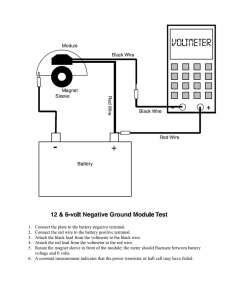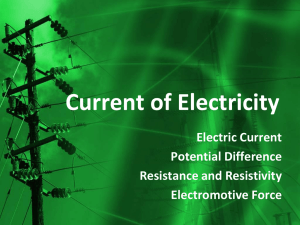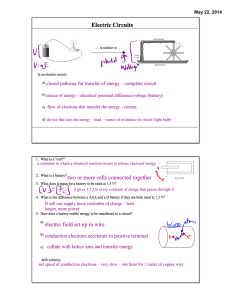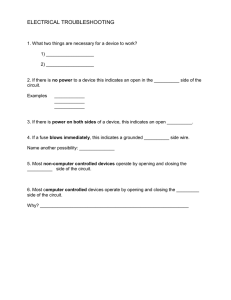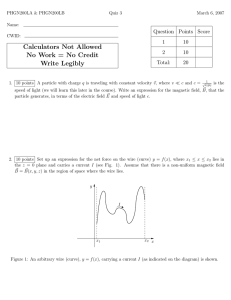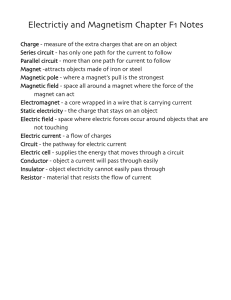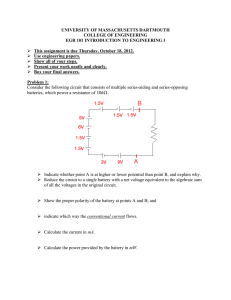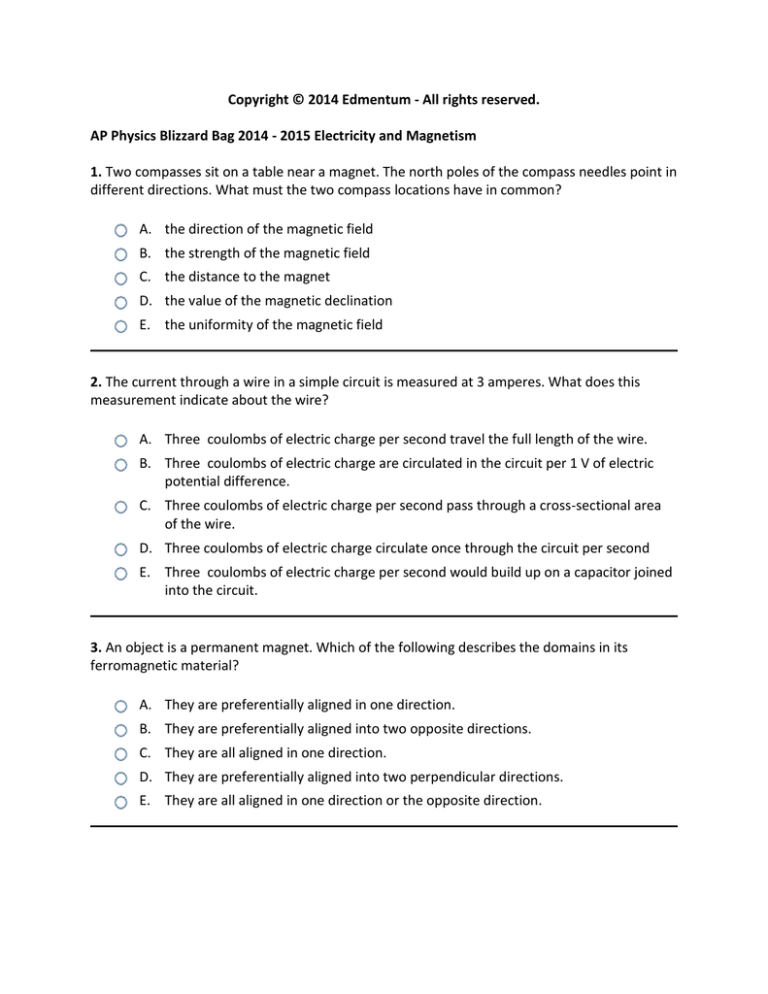
Copyright © 2014 Edmentum - All rights reserved.
AP Physics Blizzard Bag 2014 - 2015 Electricity and Magnetism
1. Two compasses sit on a table near a magnet. The north poles of the compass needles point in
different directions. What must the two compass locations have in common?
A. the direction of the magnetic field
B. the strength of the magnetic field
C. the distance to the magnet
D. the value of the magnetic declination
E. the uniformity of the magnetic field
2. The current through a wire in a simple circuit is measured at 3 amperes. What does this
measurement indicate about the wire?
A. Three coulombs of electric charge per second travel the full length of the wire.
B. Three coulombs of electric charge are circulated in the circuit per 1 V of electric
potential difference.
C. Three coulombs of electric charge per second pass through a cross-sectional area
of the wire.
D. Three coulombs of electric charge circulate once through the circuit per second
E. Three coulombs of electric charge per second would build up on a capacitor joined
into the circuit.
3. An object is a permanent magnet. Which of the following describes the domains in its
ferromagnetic material?
A. They are preferentially aligned in one direction.
B. They are preferentially aligned into two opposite directions.
C. They are all aligned in one direction.
D. They are preferentially aligned into two perpendicular directions.
E. They are all aligned in one direction or the opposite direction.
4. Many electronic devices include resistors in sections of the circuitry. The resistors act to...
A. increase the voltage difference that a battery generates.
B. decrease the voltage difference that a battery generates.
C. increase the electric current.
D. act as a "charge sink" to absorb excess charges flowing through the circuit.
E. reduce the electric current.
5. A physicist wishes to increase the capacitance of a parallel-plate capacitor that is connected
to an 8-V battery. What could accomplish this goal?
I. Replace the 8-V battery with a 12-V battery.
II. Fill the space between the capacitor with a dielectric.
III. Move the plates of the capacitor closer together, but not touching.
A. I and III only
B. I, II, and III
C. II and III only
D. II only
E. I only
6. A battery supplies an electromotive force (emf) of 16 V. When it is connected into a certain
circuit, the current is 2.0 A. What is the terminal voltage of the battery?
A. 16 V − 2.0r,where r is the net resistance of the circuit
B. 16 V − 2.0r, where r is the internal resistance of the battery
C. 16 V
D. 16 V + 2.0r, where r is the internal resistance of the battery
E. 16 V + 2.0r, where r is the net resistance of the circuit
7. According to Coulomb's law, the electrical force between two charges is directly proportional
to the ______ of the two charges and indirectly proportional to the ________ between them.
A. product; square of the distance
B. ratio; square of the distance
C. ratio; distance
D. square of the ratio; distance
E. product; distance
8. A wire carries 0.83 A toward an observer. A magnet pulls a 20 cm length of the wire to the
right with a force of 0.10 N due to the current traveling through the wire. The magnetic field is
nearly uniform and is aligned perpendicular to the wire. What is the magnitude and the
direction of the magnetic field?
A. 0.017 T; up
B. 0.60 T; up
C. 0.60 T; down
D. 0.017 T; down
E. 0 T
9. A straight wire 20 cm long carries a 15 A current between the poles of a magnet. The
magnetic field is nearly uniform at 0.60 T, and the field makes an angle of 70° with the wire.
What is the magnitude of the magnetic force on the wire?
A. 1.8 N
B. 1.7 N
C. 169 N
D. 0.6 N
E. 180 N
10. A physicist has three parallel plate capacitors, each of capacitance C, that he wishes to place
into an electric circuit. To maximize the effective capacitance in the circuit, how should the
capacitors be placed?
A. in any arrangement, because the effective capacitance will always equal 3C
B. all three in parallel
C. two in parallel, and the third in series
D. all three in series
E. in any arrangement, because the effective capacitance will always equal C
11. The unit of electric potential is the ________, which is equivalent to _________.
A. ampere (I); coulombs per second
B. farad (F); volts per meter
C. volt (V); amperes per meter
D. volt (V); joules per coulomb
E. farad (F); joules per coulomb
12. When a piece of amber is rubbed with a cloth, the amber gains a negative electric charge
because
A. an electric current forms between the amber and the cloth.
B. rubbing induces the amber to destroy positively-charged particles.
C. negatively-charged particles (electrons) transfer from the cloth to the amber.
D. negatively-charged particles (electrons) transfer from the amber to the cloth.
E. rubbing induces the amber to generate negatively-charged particles.

